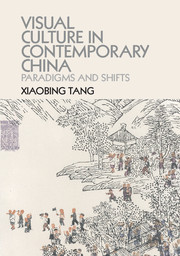Book contents
- Frontmatter
- Contents
- Acknowledgments
- A brief timeline of relevant events
- Introduction Toward a short history of visual culture in contemporary China
- Chapter 1 How was socialist visual culture created?
- Chapter 2 How was socialist visual culture created?
- Chapter 3 What do we see in New China cinema?
- Chapter 4 What does socialist visual experience mean to contemporary art?
- Chapter 5 How (not) to watch a Chinese blockbuster
- Chapter 6 Where to look for art in contemporary China
- Conclusion Seeing China from afar
- Glossary
- List of Illustrations
- Filmography
- Select bibliography
- Index
- References
Chapter 3 - What do we see in New China cinema?
Published online by Cambridge University Press: 05 January 2015
- Frontmatter
- Contents
- Acknowledgments
- A brief timeline of relevant events
- Introduction Toward a short history of visual culture in contemporary China
- Chapter 1 How was socialist visual culture created?
- Chapter 2 How was socialist visual culture created?
- Chapter 3 What do we see in New China cinema?
- Chapter 4 What does socialist visual experience mean to contemporary art?
- Chapter 5 How (not) to watch a Chinese blockbuster
- Chapter 6 Where to look for art in contemporary China
- Conclusion Seeing China from afar
- Glossary
- List of Illustrations
- Filmography
- Select bibliography
- Index
- References
Summary
A direct answer to the question above, when we understand and agree to its specific referent, may simply be this: we see New China. A more elaborate response should follow: We see cinematic expressions and projections of the idea of a New China, an idea that, as is discussed in Chapter 1, gained historic momentum and reality with the founding of the PRC in 1949 and galvanized generations of Chinese in the mid-twentieth century. What we see in the mainstream filmmaking tradition since the late 1940s are often cinematic celebrations of the making of New China – her emergence and significance as well as her promises and potentials. New China cinema, in other words, was an integral part of the project of creating a socialist New China, and it strove to illustrate how this emerging sociopolitical entity ought to be seen and imagined. It generated visions of reality and sought to have an impact on what was to become real life, but such visions should not be equated with reality itself, which we grasp as always standing in tension with its representations, cinematic or otherwise. We therefore can hardly expect to ascertain through this cinema what China was really like in the socialist era, any more than we may count on a latter-day revision or remake to reveal to us its true reality. We may also describe New China cinema in terms of what is absent from it. We do not see, for instance, outright martial arts films, dystopian fantasies, horror or erotic thrillers. Rarely do we find, even by the 1980s, crowd-pleasing slapstick comedies or auteur-centered and audience-specific art films.
- Type
- Chapter
- Information
- Visual Culture in Contemporary ChinaParadigms and Shifts, pp. 102 - 139Publisher: Cambridge University PressPrint publication year: 2015



